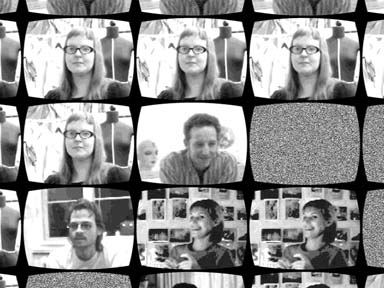| single-channel
video installation
OVERVIEW
Whilst on the one hand, covert information collection through data banks
and video surveillance is considered a sinister attack on our freedom
and rights, people willingly, sometimes even with pleasure, take part
in overt information collection in the form of questionnaires, telephone
and television interviews.
Whether this move into the public domain is shaped by external influences,
in the case of interviews, or fully self-dictated, as in the case of
an internet presence, one thing remains the same: it has to be accepted
that as soon as the step has been taken from the private into the public
sphere, the information can, and will, be used in various forms of statistical
analysis and in ways over which the individual has no more control.
The idea that one’s personal data, the things which contribute
to one’s self-image, one’s individuality, are used to create
broad statistical evaluations is, far from being felt as a threat, part
of the attraction.
The ‘Average Person’ is a being formed solely from statistical
analysis and has no real existence in terms of physical embodiment.
There is, however a tendency to conceive of this being as resembling
a real individual, to lend it a tangible form. This is seemingly justified
by the fact that this statistical ‘Average Person’ has a
powerful influence on our life and environment. It is according to the
behaviours, wishes and needs of this ‘Average Person’ that
decisions are made about how supermarkets are laid out, how tax regulations
are devised, which adverts appear where and when, how air traffic timetables
are planned. The feeling of making a small personal influence on the
attributes of the ‘Average Person’ seems to explain why
people openly give away their personal information.
Normally, an enormous amount of data is collected and analysed to form
a picture of the ‘Average Person’. In order to short-cut
this process, people were asked to answer questions as if they were
an average (0-8-15) person.
Chaos Theory predicts that patterns which appear on the microscopic
level are often found repeated on the macroscopic level. This is brought
out here by doing visually what the ‘Shepard Tone Scale’
accomplishes musically. This scale varies the volume of the notes as
they rise in pitch such that they fade in and out. When several scales
are played parallel, the effect of an ever-rising scale is produced.
VIDEO
The first interview sequence starts out full-screen. As the ‘camera’
pulls back in a constant, slow zoom, more interviewees come into view
on the surrounding monitors as if on an oversized bank of video surveillance
screens. As the pull-back proceeds, one becomes aware that the, by now
hundreds of individual monitors act as grey scale pixels which begin
to resolve into a new interview sequence. This micro- to macro-level
view shift is similar to the way in which out of the statistical analysis
of hundreds of individuals, a ‘picture’ of the ‘Average
Person’ is formed.
In the looping version of the film, the effect of a never-ending zoom
is produced. Any loop is in a banal sense non-linear. ‘0-8-15’
forms a ’strange loop’ which is more deeply non-linear because
of this micro- macro-level shift which occurs at an unidentifiable point
in time.
|

